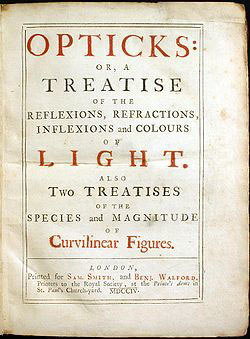 At the end of his Opticks treatise (1704) Sir Isaac Newton added a series of thirty-one queries in order to introduce a list of topics that were at the boundaries of the physics of that time. They are not only about optics; several branches of physics are touched, indicating the topics that, according to Newton, were the most important to be investigated in the immediate future. Here we present a selection of queries that are particularly interesting because they anticipated many problems that would have been under careful study for more than two centuries after the publication of the Opticks, and that received a comprehensive account only in the twentieth century, within the framework of modern theories of quantum mechanics and general relativity. Even if the terminology used by Newton is different from the modern one, queries are about the interaction between light and gravity, black body radiation, emission and absorption of electro-magnetic radiation in matter, the possibility of conversion of light into matter and vice-versa, speculations about the aether.
At the end of his Opticks treatise (1704) Sir Isaac Newton added a series of thirty-one queries in order to introduce a list of topics that were at the boundaries of the physics of that time. They are not only about optics; several branches of physics are touched, indicating the topics that, according to Newton, were the most important to be investigated in the immediate future. Here we present a selection of queries that are particularly interesting because they anticipated many problems that would have been under careful study for more than two centuries after the publication of the Opticks, and that received a comprehensive account only in the twentieth century, within the framework of modern theories of quantum mechanics and general relativity. Even if the terminology used by Newton is different from the modern one, queries are about the interaction between light and gravity, black body radiation, emission and absorption of electro-magnetic radiation in matter, the possibility of conversion of light into matter and vice-versa, speculations about the aether.
When I made the foregoing Observations, I design'd to repeat most of them with more care and exactness, and to make some new ones for determining the manner how the Rays of Light are bent in their passage by Bodies, for making the Fringes of Colours with the dark lines between them. But I was then interrupted, and cannot now think of taking these things into farther Consideration. And since I have not finish'd this part of my Design, I shall conclude with proposing only some Queries, in order to a farther search to be made by others.
 Query 1. Do not Bodies act upon Light at a distance, and by their action bend its Rays; and is not this action (caeteris paribus) strongest at the least distance?
Query 1. Do not Bodies act upon Light at a distance, and by their action bend its Rays; and is not this action (caeteris paribus) strongest at the least distance?
Qu. 5. Do not Bodies and Light act mutually upon one another; that is to say, Bodies upon Light in emitting, reflecting, refracting and inflecting it, and Light upon Bodies for heating them, and putting their parts into a vibrating motion wherein heat consists?
Qu. 8. Do not all fix'd Bodies, when heated beyond a certain degree, emit Light and shine; and is not this Emission perform'd by the vibrating motions of their parts? And do not all Bodies which abound with terrestrial parts, and especially with sulphureous ones, emit Light as often as those parts are sufficiently agitated; whether that agitation be made by Heat, or by Friction, or Percussion, or Putrefaction, or by any vital Motion, or any other Cause? [...]
Qu. 9. Is not Fire a Body heated so hot as to emit Light copiously? For what else is a red hot Iron than Fire? And what else is a burning Coal than red hot Wood?
Qu. 11. Do not great Bodies conserve their heat the longest, their parts heating one another, and may not great dense and fix'd Bodies, when heated beyond a certain degree, emit Light so copiously, as by the Emission and Re-action of its Light, and the Reflexions and Refractions of its Rays within its Pores to grow still hotter, till it comes to a certain period of heat, such as is that of the Sun? And are not the Sun and fix'd Stars great Earths vehemently hot, whose heat is conserved by the greatness of the Bodies, and the mutual Action and Reaction between them, and the Light which they emit, and whose parts are kept from fuming away, not only by their fixity, but also by the vast weight and density of the Atmospheres incumbent upon them; and very strongly compressing them, and condensing the Vapours and Exhalations which arise from them? [...]
Qu. 12. Do not the Rays of Light in falling upon the bottom of the Eye excite Vibrations in the Tunica Retina? Which Vibrations, being propagated along the solid Fibres of the optick Nerves into the Brain, cause the Sense of seeing. [...]
Qu. 16. When a Man in the dark presses either corner of his Eye with his Finger, and turns his Eye away from his Finger, he will see a Circle of Colours like those in the Feather of a Peacock's Tail. If the Eye and the Finger remain quiet these Colours vanish in a second Minute of Time, but if the Finger be moved with a quavering Motion they appear again. Do not these Colours arise from such Motions excited in the bottom of the Eye by the Pressure and Motion of the Finger, as, at other times are excited there by Light for causing Vision? And do not the Motions once excited continue about a Second of Time before they cease? And when a Man by a stroke upon his Eye sees a flash of Light, are not the like Motions excited in the Retina by the stroke? And when a Coal of Fire moved nimbly in the circumference of a Circle, makes the whole circumference appear like a Circle of Fire; is it not because the Motions excited in the bottom of the Eye by the Rays of Light are of a lasting nature, and continue till the Coal of Fire in going round returns to its former place? And considering the lastingness of the Motions excited in the bottom of the Eye by Light, are they not of a vibrating nature?
Qu. 19. Doth not the Refraction of Light proceed from the different density of this athereal Medium in different places, the Light receding always from the denser parts of the Medium? And is not the density thereof greater in free and open Spaces void of Air and other grosser Bodies, than within the Pores of Water, Glass, Crystal, Gems, and other compact Bodies? For when Light passes through Glass or Crystal, and falling very obliquely upon the farther Surface thereof is totally reflected, the total Reflexion ought to proceed rather from the density and vigour of the Medium without and beyond the Glass, than from the rarity and weakness thereof.
Qu. 21. Is not this Medium much rarer within the dense Bodies of the Sun, Stars, Planets and Comets, than in the empty celestial Spaces between them? And in passing from them to great distances, doth it not grow denser and denser perpetually, and thereby cause the gravity of those great Bodies towards one another, and of their parts towards the Bodies; every Body endeavouring to go from the denser parts of the Medium towards the rarer? [...]
Qu. 22. May not Planets and Comets, and all gross Bodies, perform their Motions more freely, and with less resistance in this ∆thereal Medium than in any Fluid, which fills all Space adequately without leaving any Pores, and by consequence is much denser than Quick-silver or Gold? And may not its resistance be so small, as to be inconsiderable? [...]
Qu. 30. Are not gross Bodies and Light convertible into one another, and may not Bodies receive much of their Activity from the Particles of Light which enter their Composition? [...]
Sir Isaac Newton, Opticks: or, a Treatise of the Reflections, Refractions, Inflections and Colours of Light, fourth edition corrected, London, Printed for William Innys at the West-End of St. Paul's, 1730, pp. 339
